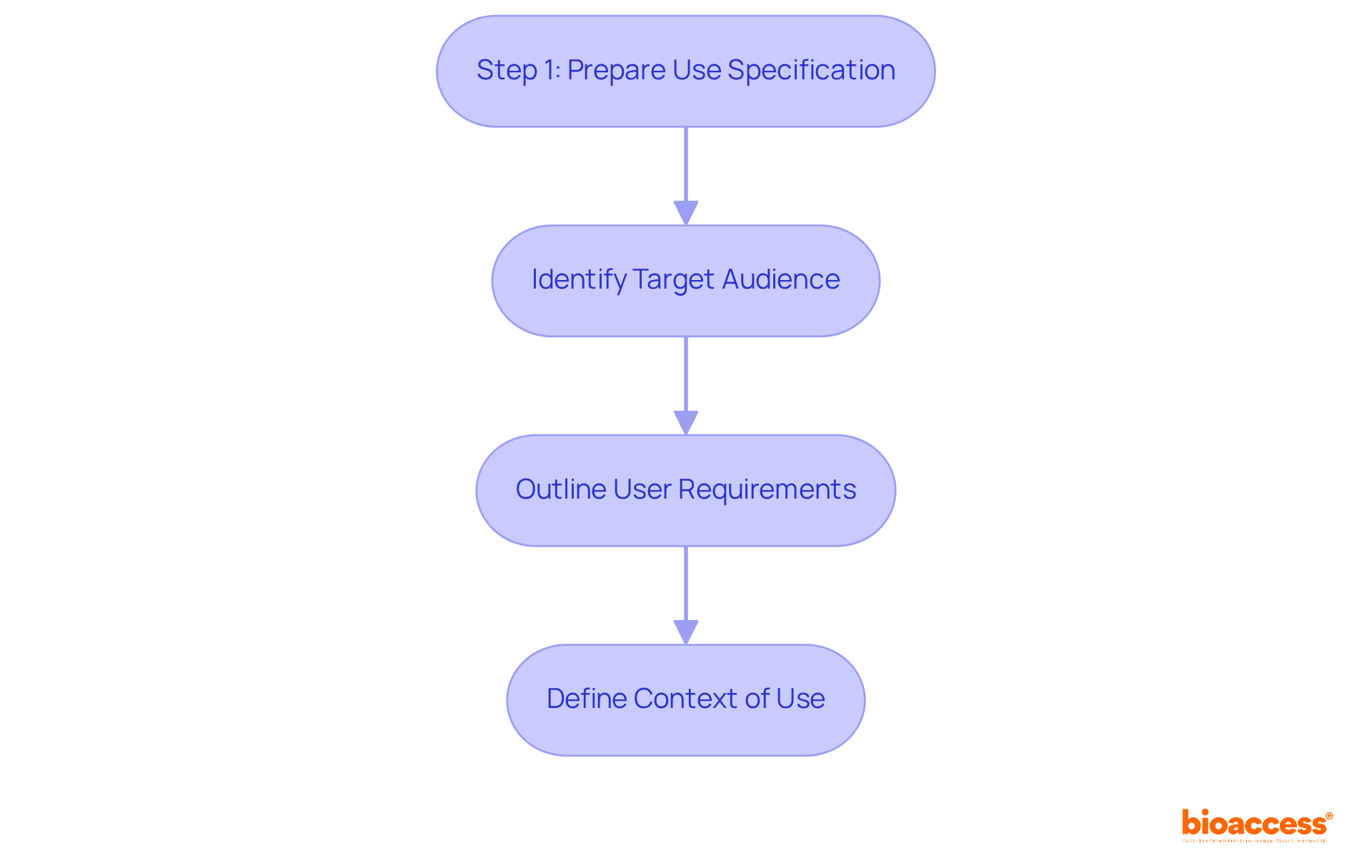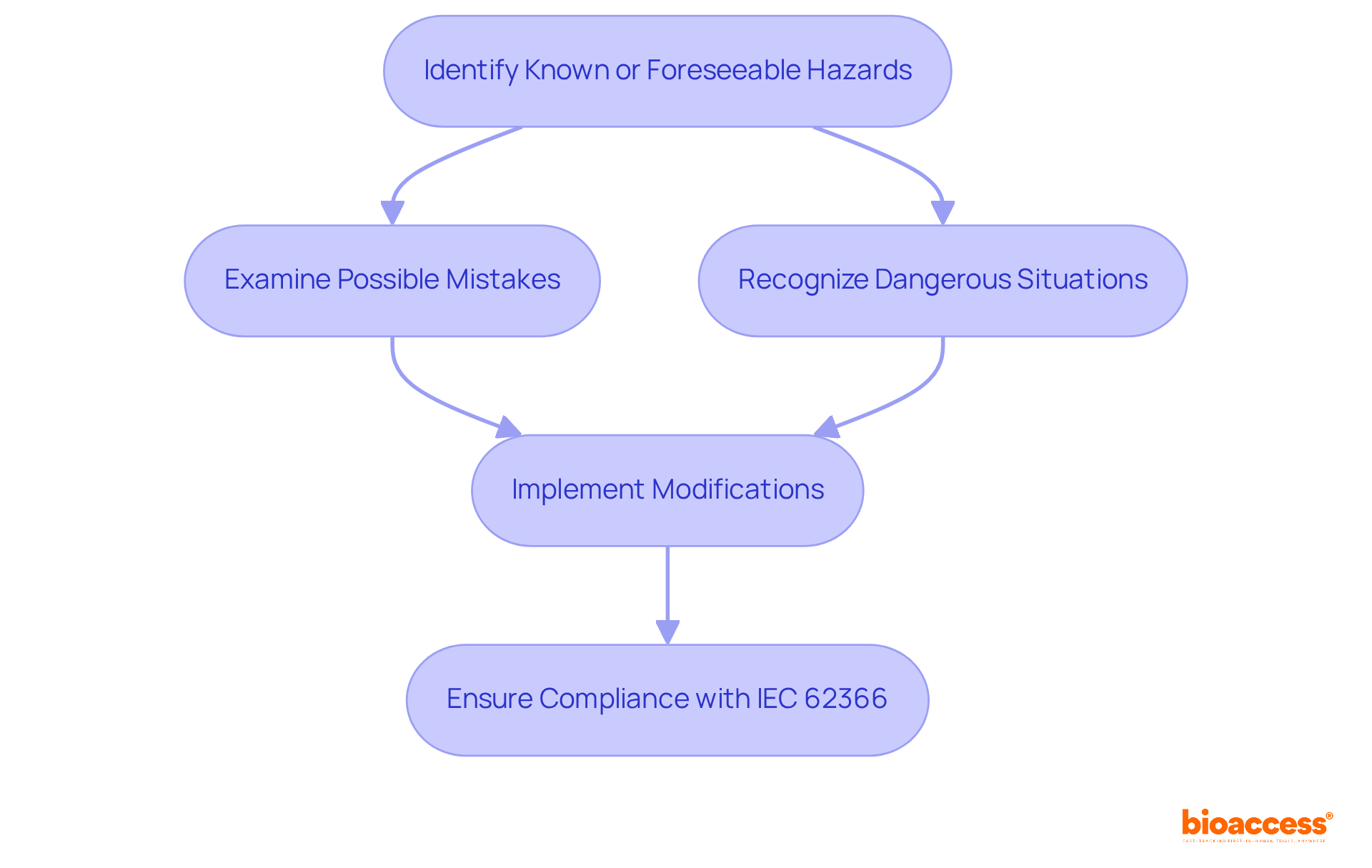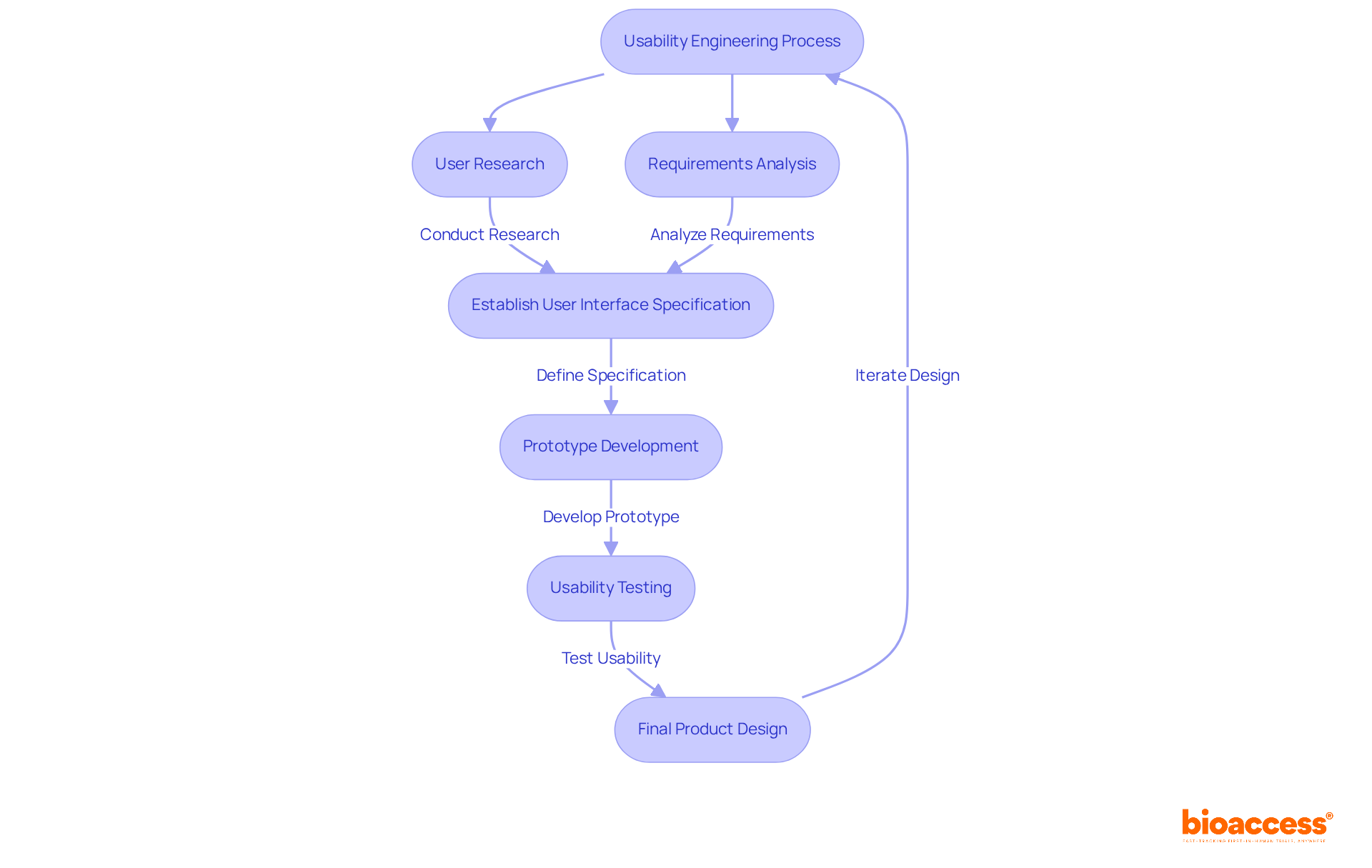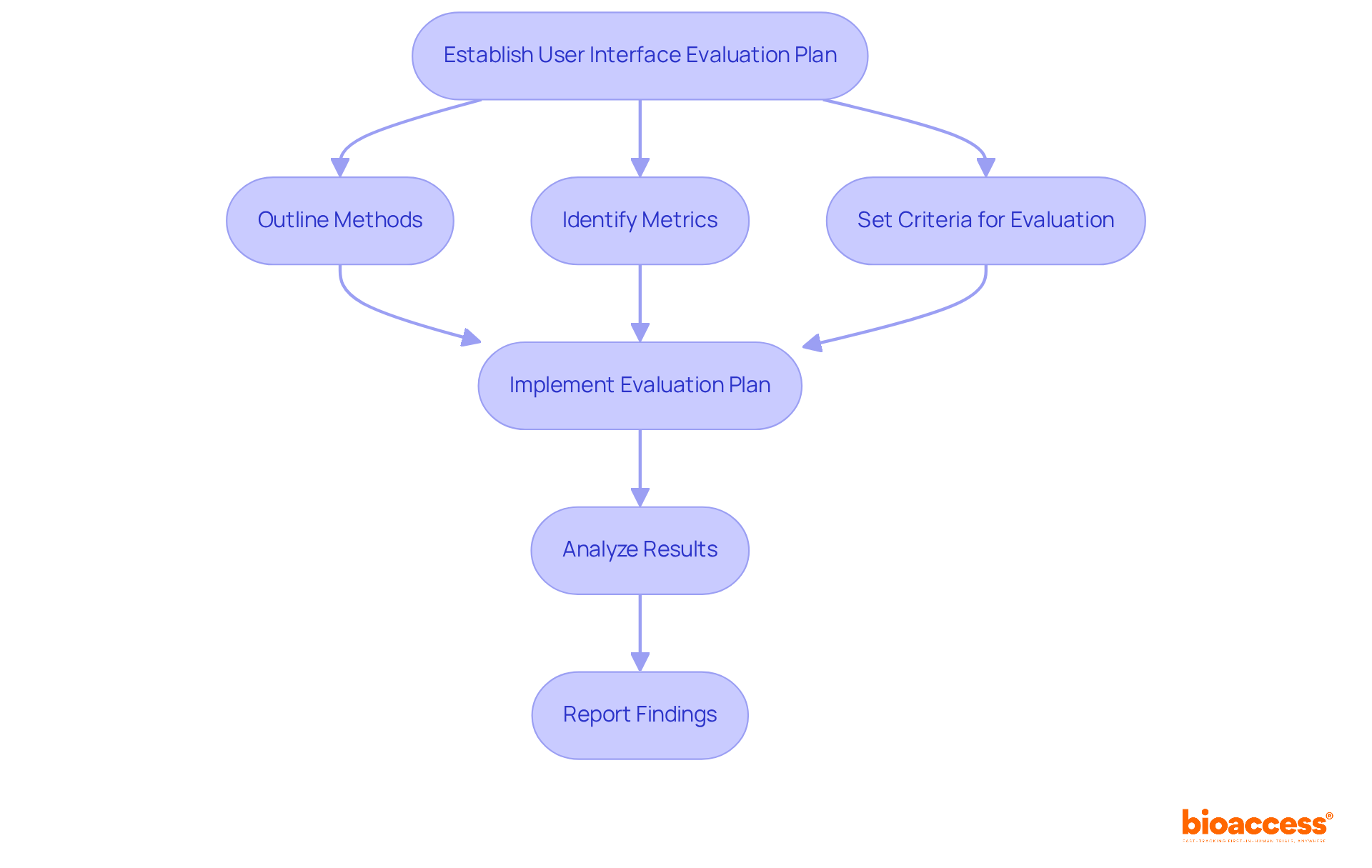


This article outlines nine essential steps for aligning usability engineering practices with IEC 62366 standards, emphasizing the critical focus on user needs and safety in the design of medical devices. It underscores the necessity of a structured approach, which includes:
Collectively, these steps ensure that products are not only user-friendly but also compliant with regulatory requirements, reinforcing the importance of meticulous design in the Medtech landscape.
The intricate world of medical device development hinges on one critical factor: usability. With over a third of medical instrument incidents attributed to user-friendliness issues, aligning with the IEC 62366 standards for usability engineering has never been more essential. This article delves into nine actionable steps that manufacturers can adopt to enhance user experience while ensuring compliance with regulatory benchmarks. How can organizations effectively navigate these complexities to create safer, more intuitive medical products that truly meet user needs?
bioaccess® is distinguished in delivering tailored clinical research services that adhere to the engineering effectiveness standards set by IEC 62366. With a wealth of experience in early-phase clinical trials, bioaccess® empowers Medtech, Biopharma, and Radiopharma innovators to adeptly navigate the complexities of engineering user interaction.
The critical nature of user-friendliness in clinical research cannot be overstated; over a third of medical instrument incidents stem from user-friendliness issues, underscoring the imperative for stringent compliance with IEC 62366 standards for user-friendliness. By securing ethical approvals and expediting enrollment processes, bioaccess® enables clients to concentrate on developing user-friendly medical products that swiftly meet regulatory benchmarks.
Recent advancements in user experience engineering have further highlighted its essential role in enhancing medical equipment safety, with successful case studies demonstrating how effective user-centered practices can lead to improved patient outcomes. As the landscape of clinical trials evolves, bioaccess® remains at the forefront, assisting clients in leveraging usability engineering to fulfill their innovation aspirations.

The initial step in aligning with the standards set by IEC 62366 is to craft a detailed use specification. This crucial document must encompass the target audience, their specific requirements, and the context in which the medical apparatus will be utilized. By meticulously outlining these components, manufacturers can foster a user-focused approach, which is essential for developing safer and more effective medical products. This focus on end-user requirements not only enhances usability but also adheres to the regulatory standards outlined in IEC 62366, thereby ensuring that the final product meets the demands of practical applications.
As the regulatory landscape evolves, particularly with the introduction of more stringent ISO/IEC standards in 2025, the urgency of compliance with these standards becomes increasingly critical. In Colombia, INVIMA plays a pivotal role in overseeing the marketing and manufacturing of health products, ensuring adherence to health standards. Recognized as a Level 4 health authority by the Pan American Health Organization and World Health Organization, INVIMA's regulations underscore the significance of effective medical equipment design.

In this step, it is essential to identify interface characteristics that could affect safety. This involves a thorough examination of how individuals engage with the apparatus and a recognition of possible points of failure. Research has demonstrated that interaction errors can significantly undermine device safety, with a substantial proportion of incidents attributed to interface shortcomings.
For instance, a support vector machine achieved 79% accuracy in multiclass classification, illustrating the effectiveness of data analysis in identifying interaction errors. By comprehending these traits, producers can develop interfaces that minimize the likelihood of mistakes, thereby enhancing overall safety and ensuring compliance with IEC 62366.
The ergonomic redesign of the Thomas & Betts Sta-Kon® ERG-4001 crimper exemplifies how ergonomic enhancements can lead to improved safety for operators and a reduction in errors within medical devices. Experts such as Kim Vicente emphasize that examining human-system interaction at various levels is crucial for mitigating mistakes made by individuals. This proactive approach not only bolsters overall safety but also guarantees adherence to the standards set by IEC 62366.
Manufacturers are urged to conduct participant testing or ergonomic evaluations to effectively implement these principles.

Recognizing known or anticipated risks linked to medical tools is a vital phase in usability engineering. This process entails a thorough examination of possible mistakes by individuals and dangerous circumstances that may arise during regular usage. Information indicates that mistake rates in medical equipment can be considerable, frequently resulting in negative occurrences. By proactively identifying these risks, manufacturers can implement modifications that enhance safety for individuals and ensure compliance with IEC 62366.
Foreseeability in product development is crucial; it enables the prediction of user interactions and the recognition of possible misuse scenarios. This method reduces risks and complies with regulatory expectations, ultimately resulting in safer medical products in the market. The significance of this proactive approach is underscored by the evolving landscape of medical equipment regulations in 2025, which increasingly stress the necessity for thorough risk evaluations and user-focused design principles.
Furthermore, referencing the Top 10 Health Technology Hazards list provides additional context regarding the importance of identifying hazards. It is essential to consider the role of post-market surveillance systems, clinical evaluation, and vigilance systems in the ongoing risk management process. Techniques such as FMEA and fault tree analysis are critical for conducting thorough risk analysis, ensuring that all potential hazards are adequately addressed.
A comprehensive Risk Management Plan should define the scope of activities, intended use of products, roles and responsibilities, and risk acceptability criteria, reinforcing the importance of a structured approach to risk management.

In this critical phase, manufacturers must systematically identify and document hazard-related use scenarios that could lead to operator errors or hazardous situations. These scenarios should accurately reflect authentic interactions with the medical apparatus, taking into account various user profiles and differing environments.
For example, a core task may encompass multiple subtasks, typically ranging from five to nine, that users must navigate, underscoring the necessity of understanding user interactions in context. Recording these situations is essential for evaluating the instrument's functionality and safety throughout the design process.
Furthermore, manufacturers are obligated to describe each use scenario included in human factors validation testing and categorize tasks as critical or non-critical, which is vital for compliance with IEC 62366. Experts in usability testing assert that the precise identification of these scenarios not only facilitates risk analysis but also contributes to compliant usability files, thereby streamlining regulatory approvals.
By focusing on practical interactions and ensuring the appropriate level of detail in documentation, manufacturers can better anticipate potential errors and enhance the overall safety and effectiveness of their products.

Following the identification of hazard-related use scenarios, the next crucial step is selecting those that will undergo summative evaluation. This selection process must prioritize scenarios that pose the highest risk of individual error or potential harm. By concentrating on these critical situations, manufacturers can ensure that their usability testing effectively addresses the most significant elements of safety and performance.
Prioritizing error scenarios related to individuals is essential, as studies indicate that mistakes often arise from difficulties in perception, cognition, and manipulation of the device interface. As Guillaume Promé states, "Your mission: to mitigate 3 sources of error: Difficulty of perception (of an alarm, a marking, a command…)."
Engaging in a comprehensive examination of participant profiles and anticipated use environments is vital for enhancing this prioritization, enabling a more focused strategy for usability testing. Defining profiles and understanding the context of use are crucial for identifying risks and managing them through design. Clinical research leaders emphasize that analyzing the context is vital for identifying risks of misuse.
By adopting a systematic approach to scenario selection, including implementing a scenario selection scheme based on risk levels as outlined in IEC 62366, manufacturers can mitigate risks and enhance the overall experience for consumers, ultimately leading to safer and more effective medical devices.

Creating an interface specification is an essential step in the usability engineering process. This document must outline the specifications for the interface, encompassing layout, functionality, and safety features. By developing a clear and detailed specification, manufacturers can effectively direct the design process. This ensures that the final product not only aligns with consumer needs but also adheres to regulatory standards.

The next phase involves the development of an interface assessment strategy that meticulously details the approach to testing for ease of use. This plan must outline the methods, metrics, and criteria essential for evaluating the interface's effectiveness and safety. By implementing a structured evaluation plan, manufacturers can ensure that their testing is both comprehensive and in strict alignment with the requirements of IEC 62366.

Crafting the interface for maximum effectiveness requires a steadfast commitment to customer-focused principles, which are essential for developing intuitive and efficient layouts. Key elements to consider encompass layout, navigation, and feedback mechanisms, all of which play a pivotal role in enhancing user satisfaction. Notably, studies reveal that:
This underscores the critical importance of prioritizing usability throughout the development process. By concentrating on these elements, manufacturers can substantially decrease the likelihood of errors during device use, ultimately yielding improved patient outcomes. As industry specialists assert, an effective layout should be evident, enabling individuals to navigate effortlessly without confusion.
Steve Krug encapsulates this notion by stating, 'Design should be self-evident, allowing individuals to navigate seamlessly without confusion.' This approach not only fosters confidence among users but also aligns with the latest standards in usability engineering, particularly IEC 62366, which emphasizes the necessity of understanding user needs and behaviors during the development process.
Implementing these principles can lead to a more gratifying experience for users, as evidenced by the fact that every dollar invested in UX can yield a return of up to $100. Furthermore, companies that embrace leading practices experience growth at twice the rate of the industry benchmark. As we look towards 2025, enhancing practicality in medical device creation will be paramount, given the sector's ongoing evolution and adaptation to user needs.

The final step in aligning with the design process is conducting formative evaluations of the interface, in accordance with IEC 62366. These assessments are essential for identifying and addressing user experience issues as they emerge. By actively integrating feedback from consumers, manufacturers can implement iterative enhancements that significantly elevate the product's usability and safety. This proactive approach not only ensures compliance with regulatory standards, including IEC 62366, but also fosters a user-centered philosophy, ultimately enhancing patient outcomes.
Iterative improvements, such as those seen with the CUE1 device for Parkinson's patients, have been shown to increase satisfaction and adherence. Engaging usability testing experts can offer valuable insights into effective evaluation methods, ensuring that the user interface adapts to real-world needs and challenges.
To implement formative evaluations effectively, consider establishing a feedback loop with end-users early in the design process, allowing for continuous refinement based on their experiences.

Aligning with IEC 62366 transcends mere regulatory compliance; it is an essential process that guarantees the creation of user-friendly medical devices, prioritizing safety and efficacy. By adhering to the outlined nine steps, manufacturers can systematically refine their usability engineering practices, ultimately leading to improved patient outcomes and adherence to critical standards.
This article explores pivotal steps, including:
Each step underscores the necessity of a user-centered approach, ensuring that devices are not only effective but also intuitive for end-users. The emphasis on formative evaluations throughout the design process highlights the importance of continuous improvement based on real-world user feedback, culminating in safer and more reliable medical products.
As the medical device regulatory landscape evolves, the importance of compliance with IEC 62366 remains paramount. Manufacturers are urged to adopt these guidelines and implement best practices in usability engineering. By prioritizing user needs and safety considerations, the industry can drive innovation that not only fulfills regulatory requirements but also enriches the overall healthcare experience.
What is bioaccess® and what services does it provide?
bioaccess® specializes in delivering tailored clinical research services that comply with the engineering effectiveness standards set by IEC 62366, helping Medtech, Biopharma, and Radiopharma innovators navigate user interaction complexities.
Why is user-friendliness important in clinical research?
User-friendliness is critical in clinical research because over a third of medical instrument incidents arise from user-friendliness issues, making compliance with IEC 62366 standards essential for developing safe and effective medical products.
How does bioaccess® assist clients in the clinical research process?
bioaccess® helps clients by securing ethical approvals and expediting enrollment processes, allowing them to focus on developing user-friendly medical products that meet regulatory benchmarks.
What role does user experience engineering play in medical device safety?
User experience engineering enhances medical equipment safety by employing user-centered practices that can lead to improved patient outcomes, as demonstrated by successful case studies.
What is the first step in aligning with IEC 62366 standards?
The first step is to prepare a detailed use specification that outlines the target audience, their specific requirements, and the context of use for the medical apparatus, fostering a user-focused approach.
Why is compliance with regulatory standards becoming more critical?
Compliance is becoming more critical due to the introduction of more stringent ISO/IEC standards in 2025, which emphasize the importance of effective medical equipment design and safety.
What is the role of INVIMA in Colombia?
INVIMA oversees the marketing and manufacturing of health products in Colombia, ensuring adherence to health standards as a recognized Level 4 health authority by the Pan American Health Organization and World Health Organization.
How can manufacturers enhance safety through user interface design?
Manufacturers can enhance safety by identifying interface characteristics that affect safety, understanding interaction errors, and redesigning interfaces to minimize mistakes, thereby ensuring compliance with IEC 62366.
What example illustrates the importance of ergonomic design in medical devices?
The ergonomic redesign of the Thomas & Betts Sta-Kon® ERG-4001 crimper demonstrates how ergonomic enhancements can lead to improved safety for operators and a reduction in errors within medical devices.
What methods can manufacturers use to implement user interface safety principles?
Manufacturers are encouraged to conduct participant testing or ergonomic evaluations to effectively implement user interface safety principles and mitigate potential errors.